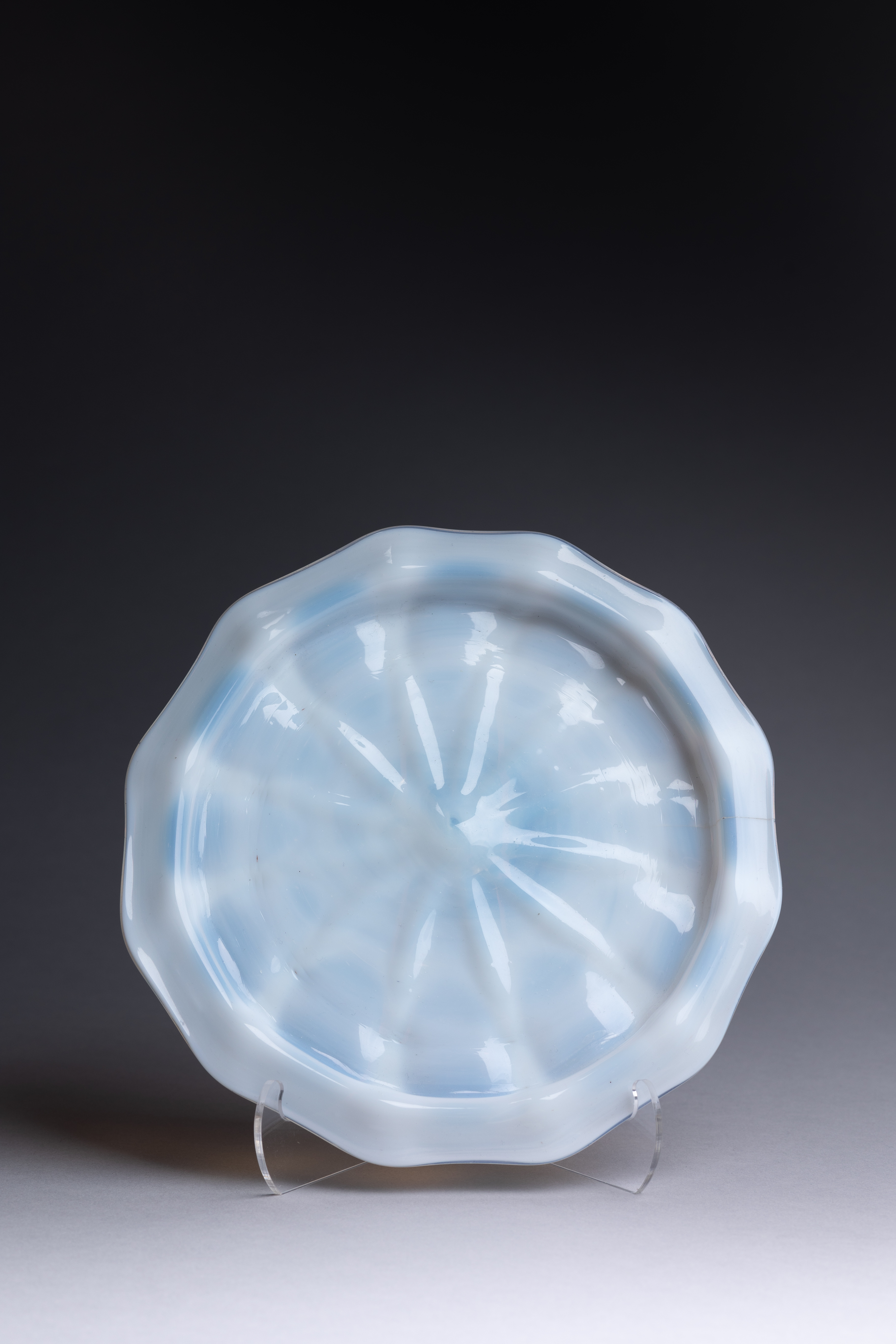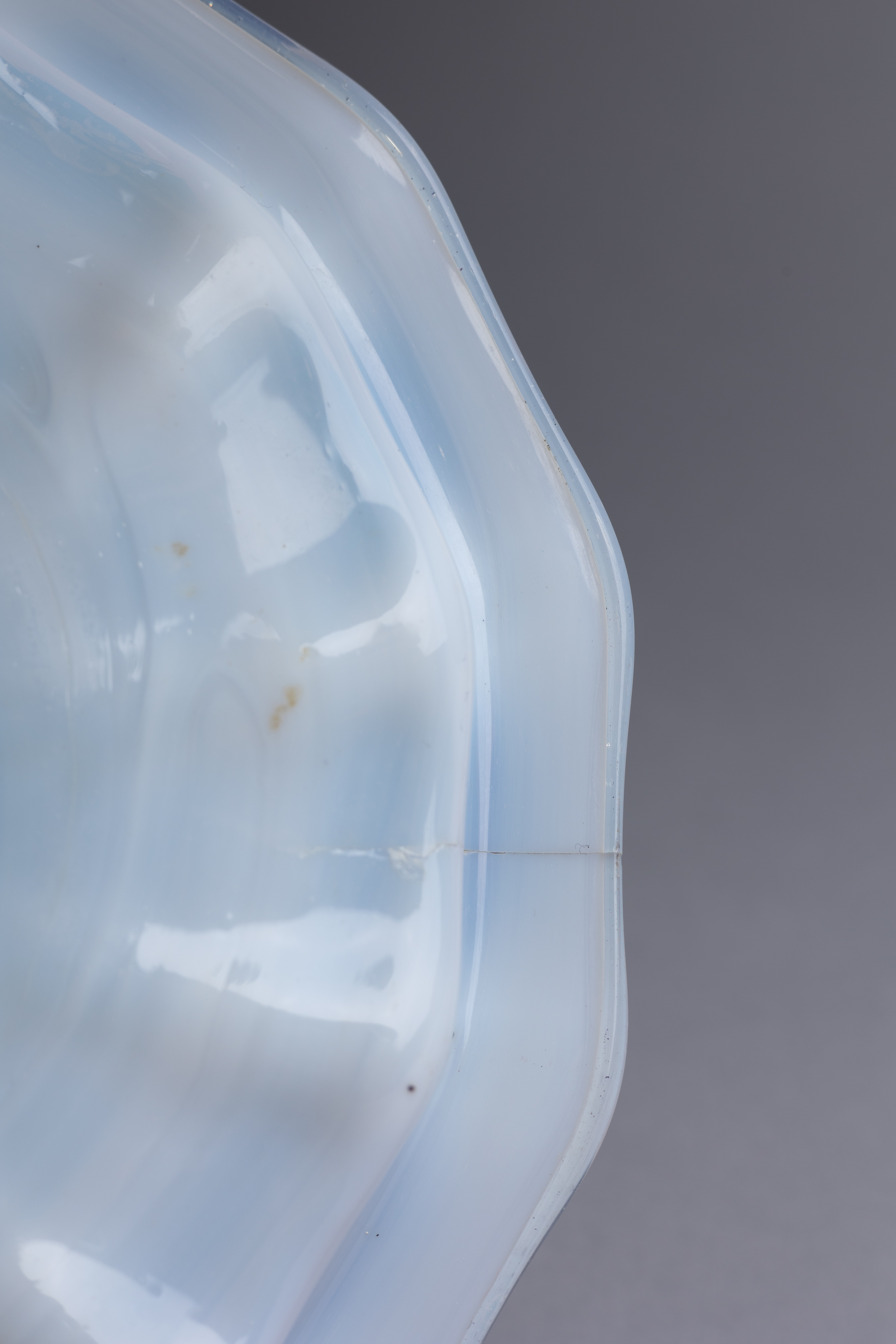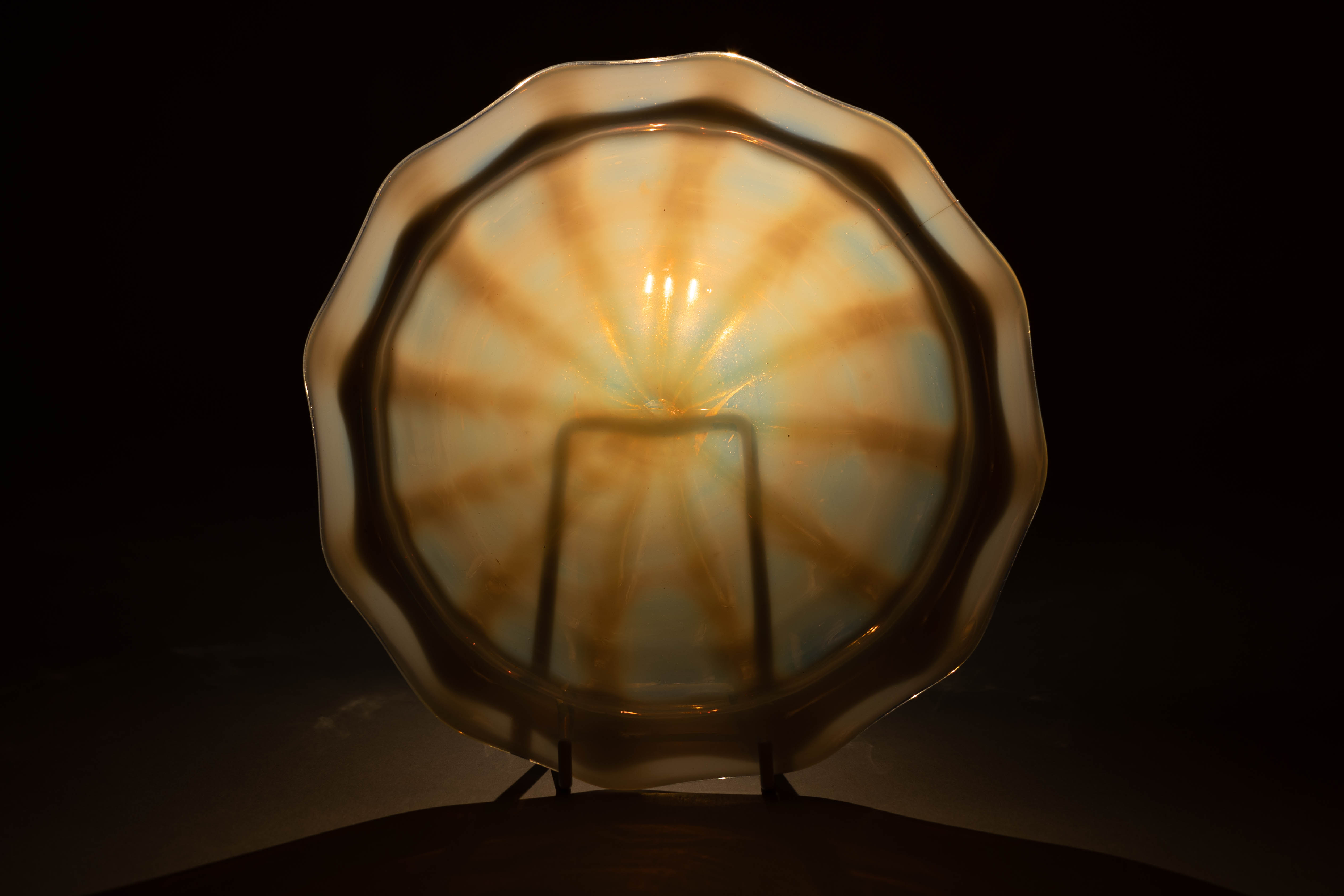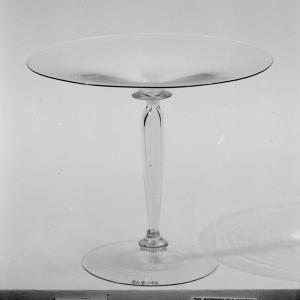An epitome of Renaissance and Baroque Venetian culture, this opal glass dish exhibits everything Venetians valued in the objects that decorated their interiors: a broad spectrum of colors, light as physical presence reflecting from the various objects, and technological feats. Combined with strikingly light weight characteristic of Early Modern Venetian glass and the wondrous orange cast when the milky blue glass meets light, it is no wonder that collectors from all over Europe sought opal glass ever since it was first introduced in the 17th century. Up to this day Venice remains synonymous with the glass industry, and opal glass keeps inspiring production and marvel.
An epitome of Renaissance and Baroque Venetian culture, this opal glass dish exhibits everything Venetians valued in the objects that decorated their interiors: a broad spectrum of colors, light as physical presence reflecting from the various objects, and technological feats. Combined with strikingly light weight characteristic of Early Modern Venetian glass and the wondrous orange cast when the milky blue glass meets light, it is no wonder that collectors from all over Europe sought opal glass ever since it was first introduced in the 17th century. Up to this day Venice remains synonymous with the glass industry, and opal glass keeps inspiring production and marvel.
Essay
“Thus, in short, to anyone considering it well, all the effects of glass are marvelous.”
-Vannoccio Biringucci, Pirotechnia, c. 1540
In the year 1708, a range of Venetian glassware was presented to Frederick IV, King of Norway and Denmark by the Signoria, the highest governmental body of what was then the Republic of Venice. Among the precious objects were opal glassware similar to the one in the Artistoric Collection. Inventoried as early as 1718, these today are still housed in the same glass cabinet built at Rosenborg Castle after Frederick IV’s 1708-9 visit to Italy, representing Frederick IV’s penchant for collecting and vivid display. Venetian opal glass was certainly worthy of a kingly gift: the stunningly light milky blue glass, the production of which was a closely guarded trade secret, enraptured all who encountered it.
Venice had been renowned for its glassmaking since antiquity, and by the thirteenth century had become a global glassmaking capital. The glassmaking trade was highly regulated and knowledge was traditionally passed on within very close circles. Governed by the glassmaker’s guild and very strict glassmaking laws, Venice was constantly trying to protect the secrets of its most prominent industry. Glassmaking was confined to the island of Murano, and imprisonment or even death were penalties for divulging any industry secrets to outsiders. Leaving Venice altogether could also be grounds for punishment in this highly secretive community.
By the mid-fifteenth century, innovative technological advances had perfected the world’s first truly clear glass (cristallo) and introduced new types of glass, such as lattimo (milk-glass), early versions of which are extremely rare (such as the Rothschild Bowl in the Corning Museum of Glass). The word lattimo had come to mean glass made milk-like by the addition of opacifying materials, such as an oxide of tin. The astounding result was a white opaque glass imitative of much admired Chinese porcelain. It is no coincidence that around the same time Italian potters had begun glazing their ceramics with a tin-based glaze, producing an opaque white ground on which to paint vivid images and in doing so creating maiolica earthenwares.
Opal glass is traditionally defined as a milky (lattimo) blue glass and was first made in Murano in the sixteenth century. Venetian glassmakers were able to embed new materials such as oxides, phosphates, and other elements to produce a glass with qualities similar to that of opal gemstones. Due to its changing colors and qualities under different lights, opal glass resembles a specific category of opal gemstones, blue-white opals which refract orange light. Ways in which opal glass interacts with light still captivates the imagination today, as seen in the Courtauld Institute’s display of a venetian opalescent glass bowl. Several cultural paradigms characterized the Venetian interior and guided admiration for these types of wares throughout the Early Modern era in Venice: a broad spectrum of colors, light as physical presence reflecting from various objects, and objects which mimicked other objects through technological feats. All of these qualities found presence and manifestation in opal glass.
The high esteem that was reserved for opal glass wares in Venice made them particularly appealing to foreign collectors. Indeed, there was no shortage of travelers to the area during what came to be known as the long eighteenth century. Throughout the seventeenth through nineteenth centuries, the English Grand Tour took wealthy, upper-class young men primarily to France and Italy to experience the customs, art, and culture of continental Europeans (as illustrated in Thomas Patch’s satirical painting A Gathering of the Dilettanti around the Medici Venus). Not unlike the tourists of today, Grand Tourists always brought back souvenirs, though instead of t-shirts and magnets travelers sent home precious Antique objects such as Attic pottery, bronzes, and marbles, and Modern works such as paintings and glasswares. It is important to note that women only rarely embarked on Grand Tour travels, doing so under great financial and social privilege. Acquired objects and collecting allowed aristocratic women to engage with Grand Tour sensibilities from the home, reflecting their good taste and connection to an Antique past which was vital to establishing a social hierarchy among the British elite.
It was during this flurry of European travel that this dish, today in the Artistoric Collection, came into the hands of Lady Maria Elizabeth Augusta ‘Lili’ Cartwright. Lady Cartwright, née von Sandizell, was of noble Bavarian descent and married Sir Thomas Cartwright, an English diplomat in Munich. Lili began to collect glass and porcelain from an early age and amassed an extraordinary collection, becoming one of the first collectors of Venetian glass. Although Lady Cartwright was not a “Grand Tourist” per se, as a diplomat’s wife living abroad she was afforded the opportunity to travel throughout the Continent and acquire the objets that were so emblematic of Grand Tour travels.
The larger the glassmaking industry became, the harder it was for the secret technique of opal glass to be confined to the island of Murano. As early as the eighteenth century, glassmakers across Europe tried their hand at emulating the much sought after opal glass: in Germany, where it came to be colloquially known as “bone glass” due to the bone ash that was used as an opacifier; in France, the great Sevres Manufactory began making their own version of opal glass in the 1800s; in England, where it was manufactured by companies like James Powell & Sons Whitefriars Glass Works (responsible also for pottery such as the canoe-shaped egg server); and in the United States by the New England Glass Company and Frederick Carder working for Steuben Glass Works at Corning, NY.
This dish is an epitome of Renaissance and Baroque Venetian culture. Coming from the glass capital of the Early Modern world, this opal glass dish exhibits everything Venetians valued in the objects that decorated their interiors. With qualities resembling that of its namesake, the opal gemstone, the wondrous blue light it catches and orange light it projects made collectors from all over Europe seek it out ever since it was first introduced in the seventeenth century. From Danish Kings, to the Rothschilds, to Grand Tourists, a collection of Italian works of art was never truly complete without Venetian opal glass.
MA
Condition
Good. Hairline crack running through rim into body measuring approximately 3.7 cm in length. Two minute chips within hairline measuring less than 0.1 cm. Some minor scattered imperfections in glass.
For a detailed condition report, please contact us.
Provenance
Lady ‘Lili’ Maria Elisabeth Augusta Cartwright (née von Sandizell)
Thence by descent to her son, William Cornwallis Cartwright, Aynhoe Park, Oxfordshire
Thence by family descent
References
Biringuccio, Vanoccio. Pirotechnia. Translated by Cyril Stanely Smith and Maria Teach Gnudi. Cambridge, MA: The MIT Press, 1966.
Boesen, Gudmund. Venetian Glass at Rosenborg Castle. Copenhagen: G. E. C. Gad, 1960.
Fortini Brown, Patricia. Private Lives in Renaissance Venice: Art, Architecture and the Family. New Haven, CT: Yale University Press, 2004.
Long, Pamela O. Openness, Secrecy, Authorship: Technical Arts and the Culture of Knowledge from Antiquity to the Renaissance. Baltimore: Johns Hopkins University Press, 2001.
McCray, W. Patrick. Glassmaking in Renaissance Venice: The Fragile Craft. Brookfield, VT: Ashgate, 1999.
Page, Jutta-Annette, Ignasi Domenech, et al. Beyond Venice: Glass in Venetian Style: 1500-1750. Corning, NY: Corning Museum of Glass, 2004.
Tait, Hugh. The Golden Age of Venetian Glass. London: British Museum Publications, 1979.
Cited Works
“Thus, in short, to anyone considering it well, all the effects of glass are marvelous.”
-Vannoccio Biringucci, Pirotechnia, c. 1540
In the year 1708, a range of Venetian glassware was presented to Frederick IV, King of Norway and Denmark by the Signoria, the highest governmental body of what was then the Republic of Venice. Among the precious objects were opal glassware similar to the one in the Artistoric Collection. Inventoried as early as 1718, these today are still housed in the same glass cabinet built at Rosenborg Castle after Frederick IV’s 1708-9 visit to Italy, representing Frederick IV’s penchant for collecting and vivid display. Venetian opal glass was certainly worthy of a kingly gift: the stunningly light milky blue glass, the production of which was a closely guarded trade secret, enraptured all who encountered it.
Venice had been renowned for its glassmaking since antiquity, and by the thirteenth century had become a global glassmaking capital. The glassmaking trade was highly regulated and knowledge was traditionally passed on within very close circles. Governed by the glassmaker’s guild and very strict glassmaking laws, Venice was constantly trying to protect the secrets of its most prominent industry. Glassmaking was confined to the island of Murano, and imprisonment or even death were penalties for divulging any industry secrets to outsiders. Leaving Venice altogether could also be grounds for punishment in this highly secretive community.
By the mid-fifteenth century, innovative technological advances had perfected the world’s first truly clear glass (cristallo) and introduced new types of glass, such as lattimo (milk-glass), early versions of which are extremely rare (such as the Rothschild Bowl in the Corning Museum of Glass). The word lattimo had come to mean glass made milk-like by the addition of opacifying materials, such as an oxide of tin. The astounding result was a white opaque glass imitative of much admired Chinese porcelain. It is no coincidence that around the same time Italian potters had begun glazing their ceramics with a tin-based glaze, producing an opaque white ground on which to paint vivid images and in doing so creating maiolica earthenwares.
Opal glass is traditionally defined as a milky (lattimo) blue glass and was first made in Murano in the sixteenth century. Venetian glassmakers were able to embed new materials such as oxides, phosphates, and other elements to produce a glass with qualities similar to that of opal gemstones. Due to its changing colors and qualities under different lights, opal glass resembles a specific category of opal gemstones, blue-white opals which refract orange light. Ways in which opal glass interacts with light still captivates the imagination today, as seen in the Courtauld Institute’s display of a venetian opalescent glass bowl. Several cultural paradigms characterized the Venetian interior and guided admiration for these types of wares throughout the Early Modern era in Venice: a broad spectrum of colors, light as physical presence reflecting from various objects, and objects which mimicked other objects through technological feats. All of these qualities found presence and manifestation in opal glass.
The high esteem that was reserved for opal glass wares in Venice made them particularly appealing to foreign collectors. Indeed, there was no shortage of travelers to the area during what came to be known as the long eighteenth century. Throughout the seventeenth through nineteenth centuries, the English Grand Tour took wealthy, upper-class young men primarily to France and Italy to experience the customs, art, and culture of continental Europeans (as illustrated in Thomas Patch’s satirical painting A Gathering of the Dilettanti around the Medici Venus). Not unlike the tourists of today, Grand Tourists always brought back souvenirs, though instead of t-shirts and magnets travelers sent home precious Antique objects such as Attic pottery, bronzes, and marbles, and Modern works such as paintings and glasswares. It is important to note that women only rarely embarked on Grand Tour travels, doing so under great financial and social privilege. Acquired objects and collecting allowed aristocratic women to engage with Grand Tour sensibilities from the home, reflecting their good taste and connection to an Antique past which was vital to establishing a social hierarchy among the British elite.
It was during this flurry of European travel that this dish, today in the Artistoric Collection, came into the hands of Lady Maria Elizabeth Augusta ‘Lili’ Cartwright. Lady Cartwright, née von Sandizell, was of noble Bavarian descent and married Sir Thomas Cartwright, an English diplomat in Munich. Lili began to collect glass and porcelain from an early age and amassed an extraordinary collection, becoming one of the first collectors of Venetian glass. Although Lady Cartwright was not a “Grand Tourist” per se, as a diplomat’s wife living abroad she was afforded the opportunity to travel throughout the Continent and acquire the objets that were so emblematic of Grand Tour travels.
The larger the glassmaking industry became, the harder it was for the secret technique of opal glass to be confined to the island of Murano. As early as the eighteenth century, glassmakers across Europe tried their hand at emulating the much sought after opal glass: in Germany, where it came to be colloquially known as “bone glass” due to the bone ash that was used as an opacifier; in France, the great Sevres Manufactory began making their own version of opal glass in the 1800s; in England, where it was manufactured by companies like James Powell & Sons Whitefriars Glass Works (responsible also for pottery such as the canoe-shaped egg server); and in the United States by the New England Glass Company and Frederick Carder working for Steuben Glass Works at Corning, NY.
This dish is an epitome of Renaissance and Baroque Venetian culture. Coming from the glass capital of the Early Modern world, this opal glass dish exhibits everything Venetians valued in the objects that decorated their interiors. With qualities resembling that of its namesake, the opal gemstone, the wondrous blue light it catches and orange light it projects made collectors from all over Europe seek it out ever since it was first introduced in the seventeenth century. From Danish Kings, to the Rothschilds, to Grand Tourists, a collection of Italian works of art was never truly complete without Venetian opal glass.
MA
Good. Hairline crack running through rim into body measuring approximately 3.7 cm in length. Two minute chips within hairline measuring less than 0.1 cm. Some minor scattered imperfections in glass.
For a detailed condition report, please contact us.
Lady ‘Lili’ Maria Elisabeth Augusta Cartwright (née von Sandizell)
Thence by descent to her son, William Cornwallis Cartwright, Aynhoe Park, Oxfordshire
Thence by family descent
Biringuccio, Vanoccio. Pirotechnia. Translated by Cyril Stanely Smith and Maria Teach Gnudi. Cambridge, MA: The MIT Press, 1966.
Boesen, Gudmund. Venetian Glass at Rosenborg Castle. Copenhagen: G. E. C. Gad, 1960.
Fortini Brown, Patricia. Private Lives in Renaissance Venice: Art, Architecture and the Family. New Haven, CT: Yale University Press, 2004.
Long, Pamela O. Openness, Secrecy, Authorship: Technical Arts and the Culture of Knowledge from Antiquity to the Renaissance. Baltimore: Johns Hopkins University Press, 2001.
McCray, W. Patrick. Glassmaking in Renaissance Venice: The Fragile Craft. Brookfield, VT: Ashgate, 1999.
Page, Jutta-Annette, Ignasi Domenech, et al. Beyond Venice: Glass in Venetian Style: 1500-1750. Corning, NY: Corning Museum of Glass, 2004.
Tait, Hugh. The Golden Age of Venetian Glass. London: British Museum Publications, 1979.
This item ships free to the continental US, and globally for a flat-rate fee of $75.
All objects are packed with utmost care by our team of expert fine art shippers. All items are shipped with parcel insurance.
For more information on our shipping policies, please visit our FAQ Page.













